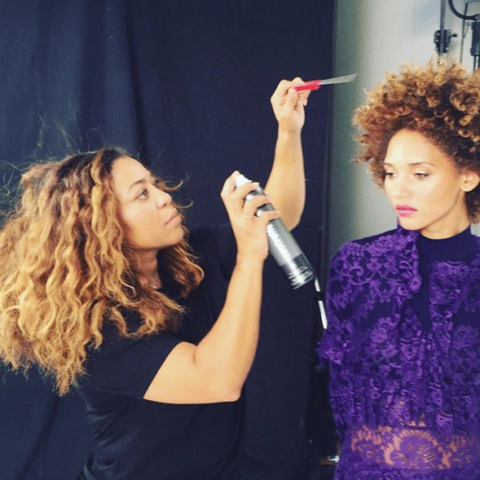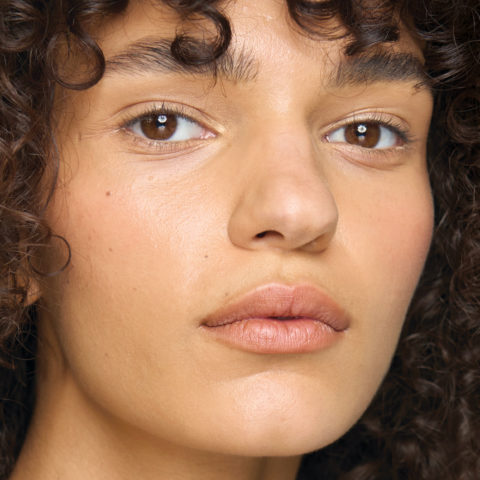Celeb Hairstylist Tippi Shorter on Working With A-Listers and The Natural Hair Shift
Tippi Shorter has been working in the beauty business for nearly 20 years. Starting out in a New York salon and transitioning to clientelle among the likes of Rihanna, Alicia Keys and Jennifer Hudson, she has been a leading voice and example for hairstylists in the industry on creating beautiful and experimental looks with natural hair.
With over 30,000 followers on Instagram, she is both parts stylist and educator, as she frequently shares videos of her styling process, products she loves and tips for texturized hair care. We chatted with the innovative stylist about the influence on the rise of social media platforms, ACV rinses and achieving healthy, moisturized curls.
How has social media changed how you do your job?
I think it’s really great. I’m getting to know and meet people I never would’ve crossed paths with – specifically hairstylists because outside of reading about them, we wouldn’t really work together on shoots. Typically there’s one hair and one makeup person. But now I get to see the work of a lot of people I admire on Instagram.
Do you think that your Instagram following has impacted your work in any way?
Totally. Aside from styling hair, a lot of my work has been in education. So I’ve been able to give tips and tricks and see trends all through social media, so it’s helped in that way. Most of my clients come through my agent but it has connected me to many brands. What I’m learning is that a lot of brands have whole teams of people who look through influencers to find people who are aligned with their mission and place them together. That’s been really great. I really need to step up my social media game!
But this wasn’t happening when you were getting into styling.
No, it definitely wasn’t – I’ve been doing this since ’95. You literally had a big, 9 x 12 portfolio that you walked around with, or my agent had in their office, and you’d have to mail it to a record company or an actress’ publicist. If they liked it, you’d be called and booked.
We’re also now aware of who’s working with the talent. Before you didn’t know who was doing Cher or Jennifer Lopez’s hair and makeup, but now you can see who is behind it. I think it’s a big thing that’s happening now, where a lot of celebrities are shouting us out. When I started, there was no place to shout it out, so no one knew what you were doing unless the weekly magazines tapped you, or you did an interview.
You specialize in texturized hair; what would you say is the most interesting trend you’ve seen?
I moved to New York from California, where most of my friends had naturally curly hair but always straightened it. When I got to New York, and I’d say 50 to 60% of the women [I met] wore their hair natural. It was a whole new, different way of hairstyling I needed to learn. I think the biggest change lately is people’s perception of someone wearing their natural hair, and their ideas around texturized hair. A lot of people think wearing your natural hair is always a political statement, but sometimes people just want to wear their hair the way it grows out of their head. If there’s been a shift, it’s other people’s perception of why someone would want to wear their natural hair.
I do know about 20 years ago, a lot of corporate companies were like “It’s this radical, black-power thing” and while it’s always going to be that way because I’m a black woman, if I choose to wear my hair curly, it’s not a stance on anything. I just have curly hair and this is how I’m choosing to wear it. I don’t even want to say acceptance, because you’re never looking for that, but I just think corporately, the overall acceptance of policies has shifted greatly. Now instead of talking about what you can’t do, not only do brands want you to wear your hair like that, they want to make some products and sell them to you. There are so many companies that are so late to the game with products for curly hair. I’ve literally worn my hair like this for 20 years, so if there’s been any change, it’s the perception of natural hair.
In terms of texturized hair, going natural can often be expensive. Many women of colour are priced out of products or don’t have the time to invest in maintenance. Do you have any advice on how to navigate this?
Yes, I created a team with two other women—Kauilani Goodwyn and Sharmelle Winsett—called the Textpert Collective, experts in textured hair. What we’re doing is going around the country to salons, and giving them expert education on textured hair colour, cut and styling. There had been a double negative – not only does the consumer not know what to do with her hair, but a lot of stylists weren’t being educated because there aren’t an abundance of classes on how to work with naturally curly hair. I can confidently say now, because I’ve been in this space educating for 7 years, is that it’s okay if you’re growing out your hair natural and you don’t know what to do. Go see a professional stylist who specializes in textured hair, because it’s going to cut your figuring it out in half, because a stylist has experience with multiple textures on a daily basis.
They might have just seen someone who has hair exactly like you. So they already know what to do with styling and upkeep at night. A lot of people are turning to YouTube and social media and seeing influencers giving advice with hair that looks similar to what they have. Visually, she might have hair just like you, but you have no idea what she did, and how she edited it to make it look, whether she hit it with a curling iron a couple of times. Who knows? I would always say see a professional because you can get great product and styling tips, which will eliminate the amount of pocket cash on trial and error.
Is there a number-one tip for styling that you can divulge?
Porosity testing is essential. Just because someone looks like they have a lot of hair doesn’t mean you can add tons of moisturizing, heavy products. If a person’s hair is non-porous, it’s just going to weigh them down and they’re going to hate the product.
A brand you often work with is Viviscal. How do you think it’s working to access women with texturized hair?
I use the Extra Strength supplements on a daily basis because I’m a huge believer of healthy hair starting from the inside. It’s a supplement you take twice daily, and it gives you thicker, fuller and shinier hair. It’s clinically tested to do just that. I use it, my mother uses it and I send it to all my clients in hopes that they use it, too. The conditioner and shampoo is for everyone who struggles with dry, brittle hair that breaks off.
What are your must-have styling products for texturized hair?
There’s a company called dpHue that has an Apple Cider Vinegar Hair Rinse. This company has an ACV-focused line. It also has essential oils and amino acids, so it cleans any debris on the scalp. For me, as a person who has to carry around a huge tub of co-wash, I can now carry this little rinse and it’ll give me three to four washes and it’s hydrating. The style product that I love is by Mizani, it’s the Twist and Coil Jelly. I don’t use it to twist, and I don’t really have coils, but it separates and defines my curls perfectly.








